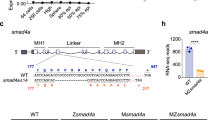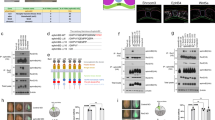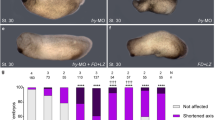Abstract
The gene lunatic fringe encodes a secreted factor with significant sequence similarity to the Drosophila gene fringe1,2,3,4,5. fringe has been proposed to function as a boundary-specific signalling molecule in the wing imaginal disc, where it is required to localize signalling activity by the protein Notch to the presumptive wing margin3,6. By targeted disruption in mouse embryos, we show here that lunatic fringe is likewise required for boundary formation. lunatic fringe mutants fail to form boundaries between individual somites, the initial segmental unit of the vertebrate trunk. In addition, the normal alternating rostral–caudal pattern of the somitic mesoderm is disrupted, suggesting that intersomitic boundary formation and rostral–caudal patterning of somites are mechanistically linked by a process that requires lunatic fringe activity. As a result, the derivatives of the somitic mesoderm, especially the axial skeleton, are severely disorganized in lunatic fringe mutants. Taken together, our results demonstrate an essential function for a vertebrate fringe homologue and suggest a model in which lunatic fringe modulates Notch signalling in the segmental plate to regulate somitogenesis and rostral–caudal patterning of somites simultaneously.
This is a preview of subscription content, access via your institution
Access options
Subscribe to this journal
Receive 51 print issues and online access
$199.00 per year
only $3.90 per issue
Buy this article
- Purchase on Springer Link
- Instant access to full article PDF
Prices may be subject to local taxes which are calculated during checkout





Similar content being viewed by others
References
Cohen, B. et al. Fringe boundaries coincide with Notch-dependent patterning centres in mammals and alter Notch-dependent development in Drosophila. Nature Genet. 16, 283–288 (1997).
Johnston, S. H. et al. Afamily of mammalian Fringe genes implicated in boundary determination and the Notch pathway. Development 124, 2245–2254 (1997).
Irvine, K. D. & Wieschaus, E. fringe, a boundary-specific signaling molecule, mediates interactions between dorsal and ventral cells during Drosophila wing develpment. Cell 79, 595–606 (1994).
Laufer, E. et al. Expression of Radical fringe in limb-bud ectoderm regulates apical ectodermal ridge formation. Nature 386, 366–373 (1997).
Wu, J. Y., Wen, L., Zhang, W. J. & Rao, Y. The secreted product of Xenopus gene lunatic fringe, a vertebrate signaling molecule. Science 273, 355–358 (1996).
Panin, V. M., Papayannopoulos, V., Wilson, R. & Irvine, K. D. Fringe modulates Notch–ligand interactions. Nature 387, 908–912 (1997).
Gossler, A. & Hrabe de Angelis, M. Somitogenesis. Curr. Top. Dev. Biol. 38, 225–287 (1998).
Christ, B., Schmidt, C., Huang, R., Wilting, J. & Brand-Saberi, B. Segmentation of the vertebrate body. Anat. Embryol. (Berlin) 197, 1–8 (1998).
Zhang, N. & Gridley, T. Defects in somite formation in lunatic fringe-deficient mice. Nature 394, 374–377 (1998).
Deutsch, U., Dressler, G. R. & Gruss, P. Pax 1, a member of a paired box homologous murine gene family, is expressed in segmented structures during development. Cell 53, 617–625 (1988).
Neubuser, A., Koseki, H. & Balling, R. Characterization and developmental expression of Pax9, a paired-box-containing gene related to Pax1. Dev. Biol. 170, 701–716 (1995).
Edmondson, D. G. & Olson, E. N. Agene with homology of the myc similarity region of MyoD1 is expressed during myogenesis and is sufficient to activate the muscle differentiation program. Genes Dev. 3, 628–640 (1989).
Mansouri, A. Paired-related murine homeobox gene expressed in the developing sclerotome, kidney, and nervous system. Dev. Dyn. 210, 53–65 (1997).
Bettenhausen, B., Hrabe de Angelis, M., Simon, D., Guenet, J. L. & Gossler, A. Transient and restricted expression during mouse embryogenesis of Dll1, a murine gene closely related to Drosophila Delta. Development 121, 2407–2418 (1995).
Dodd, J., Morton, S. B., Karagogeos, D., Yamamoto, M. & Jessell, T. M. Spatial regulation of axonal glycoprotein expression on subsets of embryonic spinal neurons. Neuron 1, 105–115 (1988).
Stern, C. D. & Keynes, R. J. Interactions between somite cells: the formation and maintenance of segment boundaries in the chick embryo. Development 99, 261–272 (1987).
Takebayashi, K., Akazawa, C., Nakanishi, S. & Kageyama, R. Structure and promoter analysis of the gene encoding the mouse helix-loop-helix factor HES-5. Indentification of the neural precursor cell-specific promoter element. J. Biol. Chem. 270, 1342–1349 (1995).
de la Pompa, J. L. et al. Conservation of the Notch signalling pathway in mammalian neurogenesis. Development 124, 1139–1148 (1997).
Swiatek, P. J., Lindsell, C. E., del Amo, F. F., Weinmaster, G. & Gridley, T. Notch1 is essential for postimplantation development in mice. Genes Dev. 8, 707–719 (1994).
Conlon, R. A., Reaume, A. G. & Rossant, J. Notch1 is required for the coordinate segmentation of somites. Development 121, 1533–1545 (1995).
1. Hrabe de Angelis, M., McIntyre, J. N. & Gossler, A. Maintenance of somite borders in mice requires the Delta homologue DII1. Nature 386, 717–721 (1997).
Williams, R., Lendahl, U. & Lardelli, M. Complementary and combinatorial patterns of Notch gene family expression during early mouse development. Mech. Dev. 53, 357–368 (1995).
Dunwoodie, S. L., Henrique, D., Harrison, S. M. & Beddington, R. S. Mouse Dll3: a novel divergent Delta gene which may complement the function of other Delta homologues during early pattern formation in the mouse embryo. Development 124, 3065–3076 (1997).
Mitsiadis, T. A., Henrique, D., Thesleff, I. & Lendahl, U. Mouse Serrate-1 (Jagged-1): expression in the developing tooth is regulated by epithelial–mesenchymal interactions and fibroblast growth factor-4. Development 124, 1473–1483 (1997).
Jen, W. C., Wettstein, D., Turner, D., Chitnis, A. & Kintner, C. The Notch ligand X-delta-2, mediates segmentation of the paraxial mesoderm in Xenopus embryos. Development 124, 1169–1178 (1997).
Riddle, R. D., Johnson, R. L., Laufer, E. & Tabin, C. Sonic hedgehog mediates the polarizing activity of the ZPA. Cell 75, 1401–1416 (1993).
McMahon, A. P. & Bradley, A. The Wnt-1 (int-1) proto-oncogene is required for development of a large region of the mouse brain. Cell 62, 1073–1085 (1990).
Hogan, B., Beddington, R., Costantini, F. & Lacy, E. Manipulating the Mouse Embryo: A Laboratory Manual (Cold Spring Harbor Press, New York, 1994).
Acknowledgements
This work was supported by grants from the German National Merit Foundation (to A.A.), the M.D. Anderson Cancer Center Core, March of Dimes, and the NIH (to R.L.J.). We thank R.Beddington, D. Conner, J. Flanagan, A. Gossler, P. Gruss, F. Guillemot, P. Hasty, D. Henrique, B. Hogan, W. Klein, E. Laufer, Y. Mishina, T. A. Mitsiadis and Y. Saga for reagents, T. Gridley for sharing unpublished results, and R. Behringer and C. Tabin for critical comments on the manuscript.
Author information
Authors and Affiliations
Corresponding author
Rights and permissions
About this article
Cite this article
Evrard, Y., Lun, Y., Aulehla, A. et al. lunatic fringe is an essential mediator of somite segmentation and patterning. Nature 394, 377–381 (1998). https://doi.org/10.1038/28632
Received:
Accepted:
Issue Date:
DOI: https://doi.org/10.1038/28632
This article is cited by
-
Reconstituting human somitogenesis in vitro
Nature (2023)
-
Nr6a1 controls Hox expression dynamics and is a master regulator of vertebrate trunk development
Nature Communications (2022)
-
Coupling delay controls synchronized oscillation in the segmentation clock
Nature (2020)
-
Identification of novel LFNG mutations in spondylocostal dysostosis
Journal of Human Genetics (2019)
-
Spinal nerve defects in mouse embryos prenatally exposed to valproic acid
Anatomical Science International (2018)
Comments
By submitting a comment you agree to abide by our Terms and Community Guidelines. If you find something abusive or that does not comply with our terms or guidelines please flag it as inappropriate.



